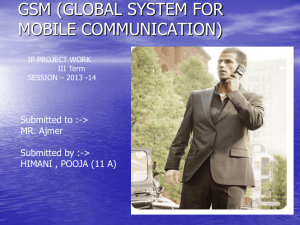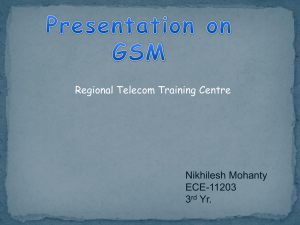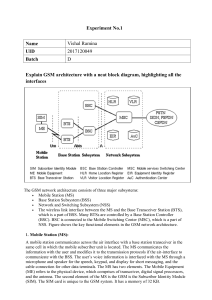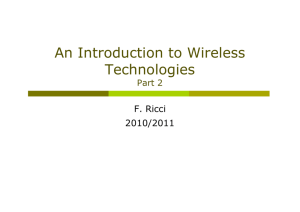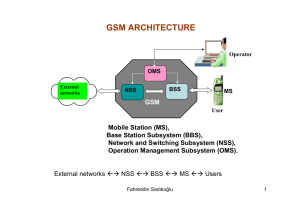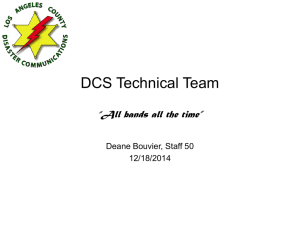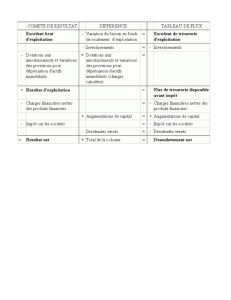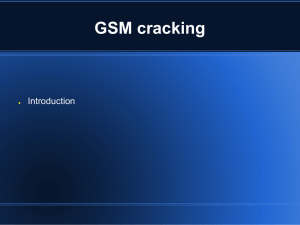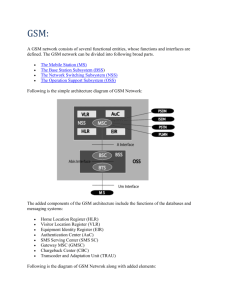Service Concept in GSM/DCS Supplementary services
advertisement
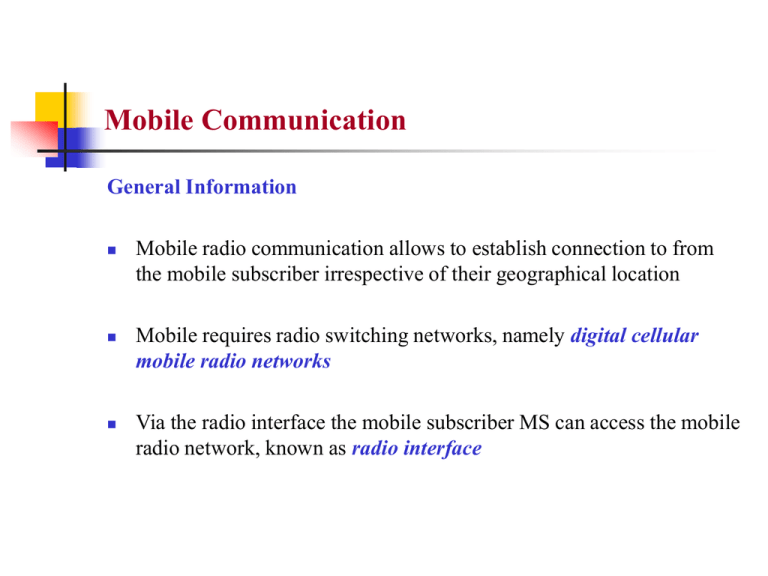
Mobile Communication General Information Mobile radio communication allows to establish connection to from the mobile subscriber irrespective of their geographical location Mobile requires radio switching networks, namely digital cellular mobile radio networks Via the radio interface the mobile subscriber MS can access the mobile radio network, known as radio interface Mobile Communication General Information On the stationary network side the radio interface is served by base station = BS On the mobile network side, the subscriber uses mobile equipment A fully digital interface, as employed in GSM/DCS is the basis of digital mobile radio network. Digital cellular Mobile Radio Network The smallest service area in a mobile radio network are called radio cells. The totality of these cells forms a so called cellular mobile radio network Every cell is served by a base station The base stations are connected to the mobile switching centre = MSC in star shaped configuration The MSC are linked to each other and also function as gateway to the fixed networks (e.g. PSTN) GSM GSM is a standard for global system for mobile communications GSM 900: GSM is a standard for digital cellular mobile radio networks (PLMN) with the digital transmission in the 900 MHz band GSM 900-PLMN are designed for extensive radio coverage even in rural areas and have a maximum cell radius of 35km DCS 1800 (Digital cellular system for 1800 MHz bandwidth) Variant of the GSM standard, which uses the 1800 MHz band for the radio interface DCS 1800 is designed for radio coverage in the areas with very high subscriber density In DCS 1800 the cells have radius upto 8km, due to this comparatively small transmit capacity it is possible to use very small size equipment Service Concept in GSM/DCS In GSM/DCS PLMN, mobile subscribers are offered three service Categories Service Concept in GSM/DCS Bearer Services: Bearer services are the pure transport service, with the bearer services the network functions required for a specific type of message transmission are clearly defined. These network functions involve for example the support of various data transmission rates(300b/s to 9.6kb/s) and modes (circuit or packet switched, synchronous or asynchronous). Service Concept in GSM/DCS Teleservices: With teleservices , not only the transport functions required for a connection setup, but also the features and the characteristics of the terminal equipment are clearly defined e.g., a specific signal protocol between the terminals Teleservices are provided upto the user access point at the terminal Equipment. Example fax service and short message service etc. Service Concept in GSM/DCS Supplementary services: Bearer and teleservises are also called the basic services Supplementary services cannot be assigned to the users without basic services Supplementary service enhances or modifies the basic services telephony i.e., call forwarding, call charge display, call hold Functional Network Architecture The GSM/DCS system consists of three subsystems Network components of radio subsystem The radio subsystem (RSS) consists of Mobile Equipment Base Station Radio Interface Network components of radio subsystem The base station (BS) terminates the radio interface (Um) on the stationary network side The base station includes Base transceiver station (BTS) Base Station Controller (BSC) Transcoding & Rate Adaptation Unit Network components of radio subsystem A BSC can control several BTS The interface between the BSC and BTS is called Abis interface The BSC,TRAU and BTS form a unit which is called Base station System Every BSC contained in the network controls one base station system (BSS) Network components of radio subsystem The BTS provides the cell with radio interface which means that it provides the radio channel and sends the cell descriptive parameters such as transmit capacity, name of the cell etc The BSC is responsible for intelligent functions in BSS It controls several BTS It distributes traffic channel connections from SSS to BTS The Network Component TRAU The Transcoding and rate adaptation unit adapts the 64kb/s (speech, data) from the MSC to the comparatively low transmission rate of the radio interface TRAU consists of two functional units The trancoder (TC) for the speech compression The rate adaptor (RD) for data rate adaptation TRAU interfaces are called A interface (to the SSS(MSC)) Asub interface to the BSC (can carry four times no of channels carried by A interface) The Network Component TRAU The Network Component TRAU TRAU can be installed on The MSC site, the network operator can save the line cost

